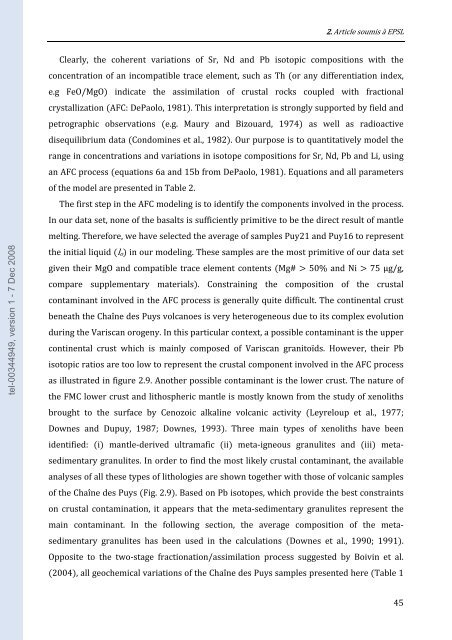Géochimie isotopique du lithium dans les basaltes-Géochimie des ...
Géochimie isotopique du lithium dans les basaltes-Géochimie des ...
Géochimie isotopique du lithium dans les basaltes-Géochimie des ...
Create successful ePaper yourself
Turn your PDF publications into a flip-book with our unique Google optimized e-Paper software.
tel-00344949, version 1 - 7 Dec 2008<br />
2. Article soumis à EPSL<br />
Clearly, the coherent variations of Sr, Nd and Pb isotopic compositions with the<br />
concentration of an incompatible trace element, such as Th �or any differentiation index,<br />
e.g FeO/MgO� indicate the assimilation of crustal rocks coupled with fractional<br />
crystallization �AFC: DePaolo, 1981�. This interpretation is strongly supported by field and<br />
petrographic observations �e.g. Maury and Bizouard, 1974� as well as radioactive<br />
disequilibrium data �Condomines et al., 1982�. Our purpose is to quantitatively model the<br />
range in concentrations and variations in isotope compositions for Sr, Nd, Pb and Li, using<br />
an AFC process �equations 6a and 15b from DePaolo, 1981�. Equations and all parameters<br />
of the model are presented in Table 2.<br />
The first step in the AFC modeling is to identify the components involved in the process.<br />
In our data set, none of the basalts is sufficiently primitive to be the direct result of mantle<br />
melting. Therefore, we have selected the average of samp<strong>les</strong> Puy21 and Puy16 to represent<br />
the initial liquid �lo� in our modeling. These samp<strong>les</strong> are the most primitive of our data set<br />
given their MgO and compatible trace element contents �Mg# � 50% and Ni � 75 μg/g,<br />
compare supplementary materials�. Constraining the composition of the crustal<br />
contaminant involved in the AFC process is generally quite difficult. The continental crust<br />
beneath the Chaîne <strong>des</strong> Puys volcanoes is very heterogeneous <strong>du</strong>e to its complex evolution<br />
<strong>du</strong>ring the Variscan orogeny. In this particular context, a possible contaminant is the upper<br />
continental crust which is mainly composed of Variscan granitoïds. However, their Pb<br />
isotopic ratios are too low to represent the crustal component involved in the AFC process<br />
as illustrated in figure 2.9. Another possible contaminant is the lower crust. The nature of<br />
the FMC lower crust and lithospheric mantle is mostly known from the study of xenoliths<br />
brought to the surface by Cenozoic alkaline volcanic activity �Leyreloup et al., 1977;<br />
Downes and Dupuy, 1987; Downes, 1993�. Three main types of xenoliths have been<br />
identified: �i� mantle‐derived ultramafic �ii� meta‐igneous granulites and �iii� meta‐<br />
sedimentary granulites. In order to find the most likely crustal contaminant, the available<br />
analyses of all these types of lithologies are shown together with those of volcanic samp<strong>les</strong><br />
of the Chaîne <strong>des</strong> Puys �Fig. 2.9�. Based on Pb isotopes, which provide the best constraints<br />
on crustal contamination, it appears that the meta‐sedimentary granulites represent the<br />
main contaminant. In the following section, the average composition of the meta‐<br />
sedimentary granulites has been used in the calculations �Downes et al., 1990; 1991�.<br />
Opposite to the two‐stage fractionation/assimilation process suggested by Boivin et al.<br />
�2004�, all geochemical variations of the Chaîne <strong>des</strong> Puys samp<strong>les</strong> presented here �Table 1<br />
45

















